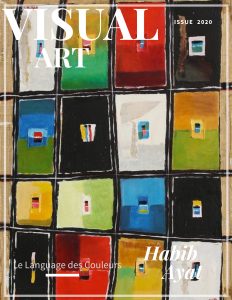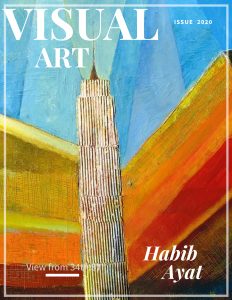The Colorful Art Meaning: Exploring the Significance of Colors in Art
Introduction:
Art is a form of expression that transcends language barriers and connects people from different cultures and backgrounds. While art can take many forms, one ofthe most powerful ways toconvey emotions and messages is through color. Colorful art meaning can range from conveying deep emotions to representing symbolic values.
In this article, wewill delve deeper into the significance of colors in art, exploring their meanings and the emotions they evoke. By understanding the different meanings of colors, we can gain adeeper appreciation for the power of art and its ability to communicate with the viewer.
The Psychology of Colors in Art (colorful art meaning)
The psychology of colors is a fascinating and complex topic. Colors have a profound effect on our emotions and can convey messages in a way that words cannot. When it comes to art, understanding the psychology of colors is crucial to appreciating the meaning behind the artwork. Here are some of the emotions and messages associated with different colors:
Red: Passion and Love
Red is apowerful color that has been used by artists throughout history to convey strong emotions and create asense of drama and intensity in their works. In art, red can symbolize a range of feelings suchas love, passion, and desire, aswell as anger, aggression, and danger.
Many artists use red in their works to create a sense of urgency and to draw theviewer’s attention to a particular element of the composition. For example, a painting of a red rose might symbolize love and passion, while a red flag might symbolize danger and warning.
In addition to its emotional connotations, red is also associated with physical attributes suchas strength, power, and energy. In sports, teams often wear red uniforms to create a sense of intimidation and dominance over their opponents. Red is also a popular color in marketing and branding, as it is believed to increase consumer interest and attention.
Overall, the use of red in art is a powerful tool for conveying a range of emotions and messages. Whether it is used to symbolize love, passion, or danger, red is a color that has the ability to capture theviewer’s attention and evoke a strong emotional response.
Yellow: Happiness and Energy
Yellow is a bright and joyful color that is often associated with sunshine, warmth, and positivity. In art, it can be used to create a feeling of happiness, energy, and optimism. Whether it is used as a dominant color or asan accent, yellow has the ability to add a cheerful and uplifting quality to a piece of artwork.
In addition to its emotional connotations, yellow can also represent intelligence and wisdom. In some cultures, yellow is associated with knowledge and learning, and itis often used in educational settings such as schools and universities. In art, yellow can be used to represent creativity and originality, as well as a sense of curiosity and exploration.
Yellow is also a popular color in fashion and design, as it is believed to be eye-catching and attention-grabbing. It is often used in branding and marketing to create a sense ofenergy and enthusiasm around a product or service.
Overall, the use of yellow in art is a powerful tool for conveying a range of emotions and messages. Whether it is used to represent happiness, intelligence, or creativity, yellow is a color that has theability to capture the viewer’s attention and evoke a positive emotional response.
Blue: Tranquility and Trust
Blue is a calming and soothing color that is often associated with feelings of tranquility, peace, and trust. In art, blue is often used to create a sense of stability and reliability, and it can beused to convey a range ofemotions, from sadness and melancholy to serenity and calmness.
Blue is also associated with intellect and wisdom, and it is often used in academic settings to represent knowledge and learning. In art, blue can be used to represent asense of intellectualism and analytical thinking, aswell as a sense of introspection and contemplation.
In addition to its emotional and intellectual connotations, blue is a versatile color that is often used in fashion and design. It can be used to create a sense of professionalism and authority, as well as a sense of serenity and calmness. Blue isalso a popular color in branding and marketing, asit is believed to be trustworthy and reliable.
Overall, the use of blue in art is a powerful tool forconveying a range of emotions and messages. Whether it is used to represent tranquility, reliability, or intellect, blue is acolor that has the ability to capture theviewer’s attention and evoke a powerful emotional response.
Green: Nature and Growth

Green is a color that is deeply connected to nature and the natural world. It represents growth, renewal, and vitality, and it is often used in art to convey a sense of harmony withthe environment. Green can be used tocreate a calming and peaceful atmosphere, and it can also evoke feelings of hope, rejuvenation, and freshness.
In addition to its association with nature, green can also represent balance, stability, and endurance. It is a color that is often associated with healing and renewal, and it is believed to have a calming and restorative effect on the mind and body. In art, green can be used tocreate a sense of balance and harmony, and it can be used to represent a sense of perseverance and endurance.
Green is also a popular color in fashion and design, as it is believed to be a versatile and adaptable color that can be used in a range of settings. It is often used in branding and marketing torepresent sustainability, health, and wellness.
Overall, the use of green in art is a powerful tool for conveying a range of emotions and messages. Whether it is used to represent nature, balance, or endurance, green is a color that has the ability to capture the viewer’s attention and evoke a strong emotional response.
Purple: Royalty and Luxury
Purple is a color that is often associated with royalty, luxury, and elegance. It is a color that has been historically used to signify power and wealth, and it is often used in art tocreate a sense of sophistication and opulence. Purple can be used to create a regal and majestic atmosphere, and it is a popular choice for creating a sense of grandeur in art and design.
In addition to its association with luxury, purple can also represent creativity and spirituality. It is a color that is often associated with artistic expression, and it canbe used to represent imagination and innovation. Purple is also associated with spiritual awareness and enlightenment, and it is often used in art to represent a sense of inner wisdom and self-awareness.
Purple is a versatile color that can be used in a range ofsettings, from fashion and design to branding and marketing. It is often used in high-end products and services to create a sense ofexclusivity and sophistication.
Overall, the use of purple in art is a powerful tool for conveying a range of emotions and messages. Whether it is used to represent royalty, creativity, or spirituality, purple is a color that has the ability to capture theviewer’s attention and evoke a strong emotional response.
Orange: Warmth and Excitement

Orange is a color that is warm, vibrant, and full of energy. It is a color that is associated with excitement, enthusiasm, and warmth, and it is often used in art to convey asense of passion and vibrancy. Orange can be used to create a dynamic and engaging atmosphere, and it is a popular choice for creating a sense of energy and movement in art and design.
In addition to its association with excitement and enthusiasm, orange can also represent courage and confidence. It is a color that is often used to represent bravery, and it can be used tocreate a sense of strength and determination. Orange isalso associated with innovation and creativity, and it is a popular choice for representing new ideas and fresh perspectives.
Orange is a versatile color that can beused in a range of settings, from fashion and design to branding and marketing. It is often used in products and services that are intended to evoke a sense of excitement and adventure, such as sports and outdoor activities.
Overall, the use of orange in art is a powerful tool forconveying a range of emotions and messages. Whether it is used to represent excitement, courage, or creativity, orange is a color that has the ability to capture theviewer’s attention and evoke a strong emotional response.
Black: Elegance and Mystery

Black is a color that is often associated with elegance, sophistication, and mystery. It is a color that has been historically used to signify power and authority, and it is often used in art to create a sense of depth and complexity. Black canbe used to create a dramatic and impactful atmosphere, and it is apopular choice for creating a sense of drama and intrigue in art and design.
In addition to its association with elegance and mystery, black can also represent power and authority. It is a color that is often used to represent strength and control, and it can be used to create a sense of seriousness and professionalism. Black is also associated with sophistication and exclusivity, and it is a popular choice for high-end products and services.
Black is a versatile color thatcan be used in a range of settings, from fashion and design to branding and marketing. It is often used in products and services that are intended to convey a sense of luxury and exclusivity, such as luxury cars and high-end fashion.
Overall, the use of black in art is a powerful tool for conveying a range of emotions and messages. Whether it is used to represent elegance, power, or sophistication, black is a color that has the ability to capture theviewer’s attention and evoke a strong emotional response.
White: Purity and Innocence

White is a color that is often associated with purity, innocence, and goodness. It is a color that has been historically used to signify a clean slate or a fresh start. It is often used in art to create asense of simplicity, clarity, and cleanliness. White can be used to create a calming and refreshing atmosphere, and it is a popular choice for creating a sense of serenity and peace in art and design.
In addition to its association with purity and innocence, white can also represent new beginnings and clarity. It is a color that is often used to represent a new chapter in life, and it can be used to create a sense ofhope and optimism. White is also associated with perfection and excellence, and it is a popular choice for creating a sense ofprofessionalism and sophistication.
White is a versatile color that can be used in a range of settings, from fashion and design to branding and marketing. It is often used in products and services thaare intended to convey a sense of purity and simplicity, such as healthcare and beauty products.
Overall, the use of white in art is a powerful tool for conveying a range of emotions and messages. Whether it is used to represent purity, new beginnings, or simplicity, white is a color that has the ability tocapture the viewer’s attention and evoke a strong emotional response.
In conclusion (colorful art meaning)
Understanding the psychology of colors is crucial toappreciating the colorful art meaning. By understanding the emotions and messages associated with different colors, we can gain a deeper understanding of the meaning behind an artwork and the message the artist is trying to convey.
Understanding the meanings of different colors is an essential aspect of art creation. Colors are one of the primary tools used by artists to evoke emotions and convey messages. By using different color combinations, artists can create unique and powerful visual experiences that elicit specific feelings or moods inthe viewer.
Color is a powerful tool that can be used to create depth, balance, and contrast in an artwork. When an artist chooses touse a particular color, they are making a deliberate decision tocommunicate a specific message or emotion to the viewer. Each color has its unique psychological and emotional associations, and the way it is used can significantly impact the interpretation of the artwork.
For example, an artist may choose to use warm colors like red, orange, and yellow to create a sense of energy and excitement. Alternatively, they may use cool colors like blue and green to create a feeling of calm and tranquility. Black and white, on the other hand, are often used to create contrast and highlight specific aspects of anartwork.
In addition to evoking emotions, color can also be used toconvey messages and ideas. For instance, an artist may use green to convey the importance of environmental preservation, or they may use red to draw attention to a social or political issue. The use of color in art is a powerful way to communicate important messages and ideas to the viewer.
In conclusion, understanding the meanings of different colors is essential for both appreciating and creating art. By using color to evoke emotions and convey messages, artists can create unique and powerful visual experiences that resonate withviewers. The use of color inart is a complex and nuanced process that requires skill and intentionality, and the result is a stunning and emotive artwork that speaks to the viewer on many levels.
FAQs:
Q. What does color mean for art?
A. Color is an essential element of art that can be used to convey various emotions, moods, and themes. It can be used to create contrast, depth, and harmony within a work of art. Colors can also represent symbolism and cultural meanings.
Q. What do colorful colors represent?
A. Colorful colors can represent various emotions and themes in art. Forexample, red can represent passion, love, or anger, while blue can represent calmness or sadness. Yellow can symbolize happiness, and green can represent nature and growth. The use of bright colors can also convey a sense ofenergy and excitement in a work of art.
Q. What do bright colors represent in art?
A. Bright colors are often used to create contrast, depth, and emphasis in a work of art. They can represent a sense of energy, excitement, and vibrancy. Bright colors can also symbolize optimism, hope, and happiness. However, the meaning of bright colors can vary depending onthe cultural and historical context of the artwork.
Q. Can colors have different meanings in different cultures?
A. Yes, the meanings of colors can vary across cultures. Forexample, in some cultures, white represents death and mourning, whereas in others, it represents purity and innocence.
Q. Can artists use more than one color to convey a message?
A. Absolutely. Artists often use multiple colors in their works to convey complex emotions and messages. The combination of different colors can create new meanings and evoke a wide range of emotions.
Q. Can colors impact our mood?
A. Yes, colors can have a profound impact onour moods and emotions. For example, warm colors such as red and orange can evoke feelings of energy and passion, while cool colors like blue and green can convey a sense ofcalm and tranquility.
Conclusion:
The colorful art meaning is a fascinating topic that showcases the power of art toconvey emotions and messages through the use of colors. By understanding the meanings of different colors, we can gain a deeper appreciation for art and its ability to communicate with the viewer. Whether it is a vibrant red painting or a tranquil blue sculpture, color has the power to move us and touch our hearts in ways that words cannot.




